for Part 1: Is It Nutritional Deficiencies? click here.
Part 2: Bugs & Part 3: Disease are found below.
My Citrus Trees Look Like This: Is it Bugs or Disease?
Ok, NOW FOR BUGS --- UGH !!!
Now for a look at the most common pest problems which lead to disease. There's really just 3 or 4 pests that we need to get really concerned with when growing citrus in FL.
But let me just give you the solutions first.
Our most trusted topical bug spray is Organocide 3-in-1, available in stores, online or on our truck. It generally gets all the pests in their infant states, and the softer shell bugs in their adult state, without harming the beneficial ladybugs, bees etc.
We use the Organocide as we see the bugs, several times, 2-10 days apart, depending on the severity and the tenacity of the infestation.
Our second line of attack --- and maybe the most important --- is to pro-actively treat the soils to eliminate bug larvae and non-beneficial microbes before the problems start. For this we use a special kind of cedar oil: modified Texas red cedar oil mixed with ethyl lactate (made from organic, non-gmo corn). It comes in a ready-to-use formula or in a concentrate (cheaper).
Read more on this here.
We suggest treating soils in the late fall / early winter, and again in early spring, before the warm weather wakes up the varmints. Another application in late spring is useful as well as soon as you start experiencing bug issues.
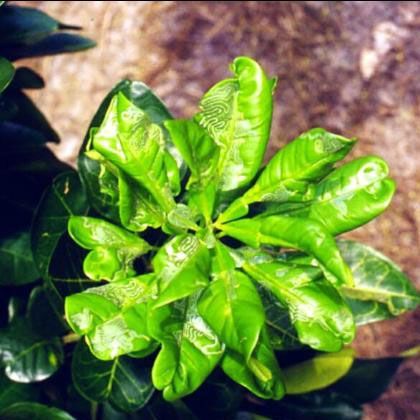
this damage is caused by bugs: citrus leaf miners
'Modified' Texas red cedar oil mixed with ethyl lactate in a 85/15 proportion is probably our single most effective pro-active treatment for bugs and non-beneficial microbes that we've found to date. I wouldn't be without it.
We now distribute this product because supply in FL is otherwise limited and the wrong cedar oil product simply doesn't give the same results -- brand matters.
And the cool thing is it doesn't hurt the beneficial insects either!
To order, click here.
Now for the bugs.
The first bug attack on citrus in FL is often the black aphids. They attack the fresh new growth because it is so tender. The photo to the right is a good example of what you'll see:
As soon as you see the black aphids, spray immediately with the Organocide 3-in-1 before they spread, multiply, or get joined by any other kinds of bugs! Usually one application will do.
Best to apply in the mornings or early evening, and not in full sun because too much sun will heat the oil and "fry" the plant. Without treatment, the aphids suck the life out of any new growth and the leaves are useless as they don't finish forming.
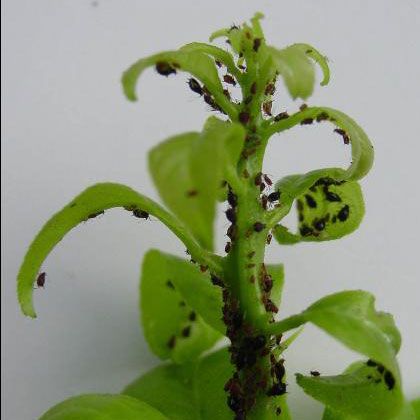
black aphids attack the tender new growth

this damage is caused by bugs: citrus leaf miners
The second bug attack in FL to citrus is usually the leaf miners. Again, they attack the fresh new growth first and look like the picture on the left.
9 times out of 10, you'll see the aphids first if at all, and the leaf miners second. As soon as you see them, spray with the Organocide 3-in-1. These are more stubborn than the aphids and usually take us 2-4 applications to stop them.
The leaves won't recover or repair: you either have to cut off the affected branch tips, or wait for them to shed these leaves and re-grow more foliage. I usually opt for cutting off the unsightly mess so that I can tell when we have new damage happening.
Bug #3: Asian citrus psyllid.
Now, the third wave is the dreaded Asian citrus psyllid. They are generally too small to see except with a magnifying glass, unless you have so many that you've already lost your grove.
At issue here is the Asian citrus psyllid spreads the Huanglongbing bacteria (HLB) that we dub "Greening disease". It is thought to have originated in China in the early 1900's, or perhaps in India in the 1700's.
Once a branch is infected, the bacteria goes systemic and slowly deprives the tree of nutrition by plugging the nutrient transport passageways with debris.
Gnat-sized Asian citrus psyllids are often found first on new growth in the interior of the tree.
The picture to the right shows what they look like up close and personal.

Asian citrus psyllids
Scientists have not found a cure for the bacteria once a tree is infected. However, organic advocates have found that the bacteria can be controlled and damage partially reversed with intensive nutrition therapy if caught in the early stages. Whether or not the bacteria can be eliminated from the tree is yet to be seen.
It is hoped that with time we'll find a way to help trees get on top of this micro-organism and even develop immunity. Click here to read more about how Maury Boyd, a brave grower who tried something different, pioneered this research and saved his grove, beginning in 2006.
After all, this bacteria has been causing damage around the world since 1700's: so why did it just now crop up in the US and wreck havoc starting in 2005? It's not like we've been living in a vacuum.
Guavas appear to repel the psyllids
Research in Vietnam reveals that intercropping citrus orchards with guavas appears to inhibit psyllid infestations significantly. Vietnamese, Japanese, and Australian scientists met in 2006 at the Japanese International Research Center for Agricultural Sciences in Ishigaki, Okinawa den, Japan to discuss.
The USDA is now conducting further studies in Fort Pierce FL.
Ladybugs, spiders and ants appear to be feeding on the juvenile psyllids
Research in 2004 (pg 9) on using parasitic wasps to reduce the population of psyllids yielded 2 surprising results. "First, T. radiata (the wasp) is but a minor contributor to natural mortality of psyllid juveniles in FL: only about 1%. . . Second, FL has a large number of native organisms (that are feeding on the psyllids). . . which include ladybugs, spiders, and ants . . . (perhaps as much as) 90% (responsible for mortality rates.) (Michaud, 2004)
DISEASES
The next category of citrus issues is disease itself.
Disease often sets in AFTER malnutrition, and/or AFTER a bug attack. Separating disease and bugs is sometimes not even possible.
These are just the most common concerns. Many of the photos below are found on the IFAS website here.
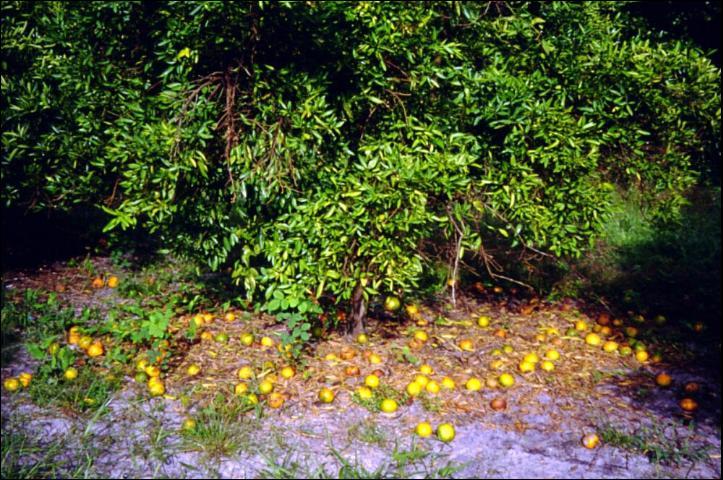
fruit drop happens: it's what you do next that saves your tree
GREENING
We've already talked about Greening --- aka HLB in our discussion about the Asian Citrus Psyllid that is the vector that spreads the bacteria, commonly called HLB or Huanglongbing. Or Yellow Dragon disease.
Many of the symptoms look like malnutrition, but frequently it starts on just one side of the tree. And it makes the fruit bitter and misshapen. You can study more pictures here.
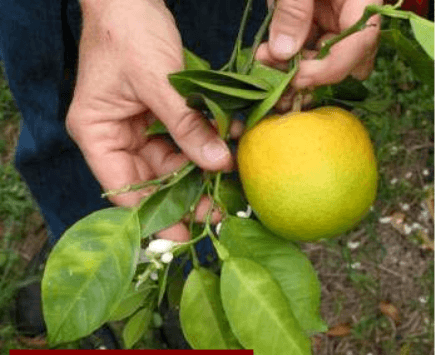
fruit ripening is inverted: notice the blossom end stays green: blossom end should ripen first in a healthy tree

blotching has NO symmetry if caused by greening
Citrus canker.
Caused by a bacterial pathogen. The disease causes lesions on the stems, leaves and fruit, and causes premature fruit drop. Typically it looks like this:
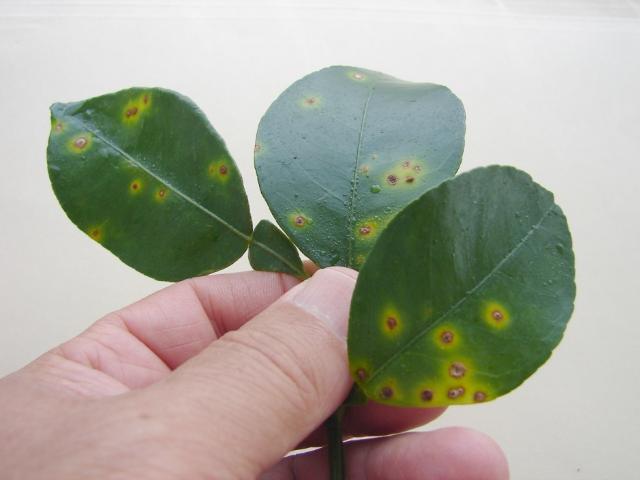
citrus canker on a leaf
Conventional recommended treatment protocols include spraying with a copper fungicide.
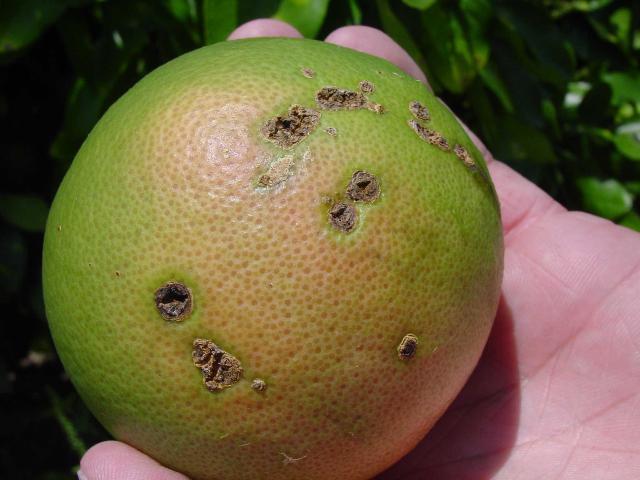
citrus canker on the fruit
Bacterial infections can be harder to fight than fungal or mold. Since it often spends part of it's life in the soil, the cedar oil / Pro-Choice is still the best place to start.
The next treatment we would use (though we've never experienced this one), is to treat both the soil and the tree leaves and fruit with the NutriHold humic acid w/ beneficials. The beneficial bacteria and beneficial fungi will set to work destroying the bacteria pathogen.
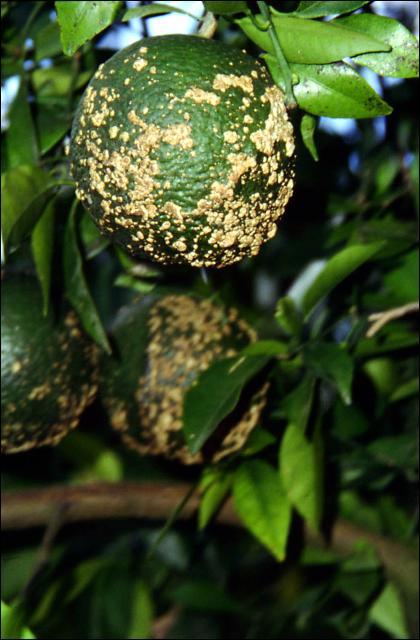
citrus scab is a fungal disease
Citrus Scab.
Unsightly pink to grey wart-like lesions that look like the photo on the left.
This is a fungal disease that primarily affects grapefruits and some tangerine hybrids like Honey Murcotts.
Lesions can start out a pinkish-pale-brown and then turn darker and more pronounced.
The modified Texas red cedar oil --- Pro-Choice --- is our first choice for anything fungal or mold. Treating the ground first is the number one first step and can be done anytime of the season. We also spray the entire citrus tree, making sure to get all leaf surfaces whenever needed.
The oil is OMRI listed and has no restrictions on using it seasonally, nor does it harm the beneficials like bees or ladybugs or praying mantis etc. It is water-friendly so spraying right after a good rain helps it to spread further and more efficiently.
Greasy Spot.
Spores germinate on the underneath of leaves, permeate the leaf and appear from the top as yellow spots that turn into ugly brown blisters, causing defoliation and fruit reduction.
"Spores", "mold" or "fungi"--- these are all trigger words that should have you reaching for the cedar oil right away. Affected leaves do not always clean up entirely: sometimes they have to simply be replaced by regrowing. So it is much easier to treat your soils before you have this kind of issue.
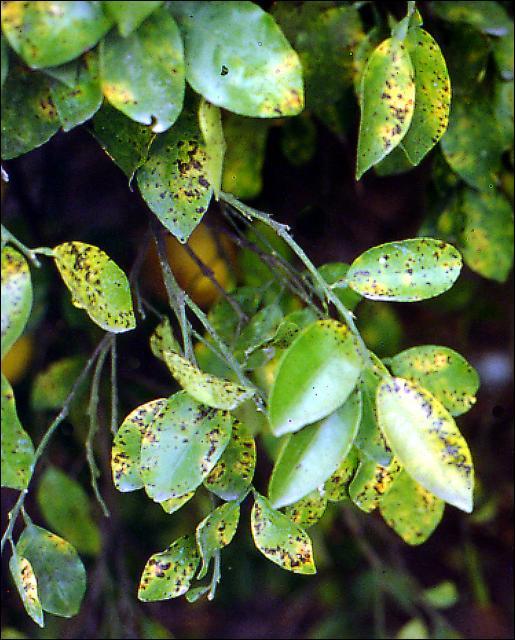
another job for cedar oil!
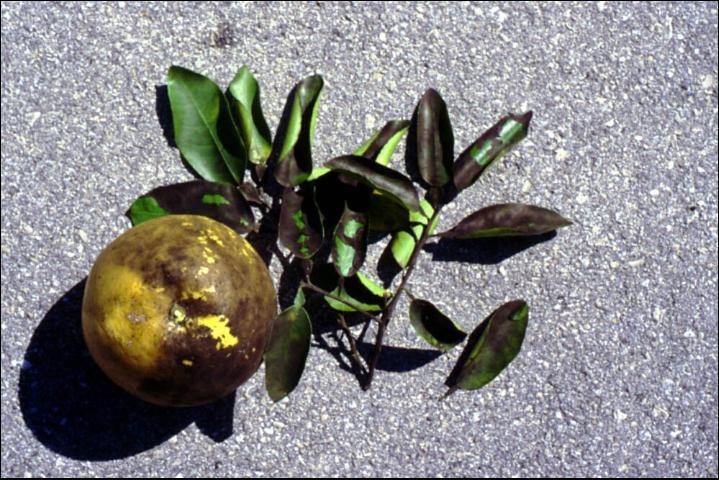
ugh --- sooty mold!
Sooty mold.
Fungal overgrowth that often follows severe insect infestations because the fungi feeds on the sugary sap left by the biting insects.
This is clearly a job for the cedar oil spray! Spray the entire tree and the soil. If infestation is really severe, some foliage may have to be re-grown.
It is often helpful with this kind of mold presentation, to simply "power-wash" the entire tree before applying either of the oils. It knocks back the problem so you don't have to waste as much product.
Citrus Rust Mite
Rust mite injury occurs as the weather warms and the mites multiply, damaging the fruits and reducing yields. The discoloration may not show until the fruit is closer to ripening. The damage looks like this:
Where there are mites, always reach for the Organocide 3-in-1 AND the cedar oil: between the two, the insects should be history in just a few treatments.
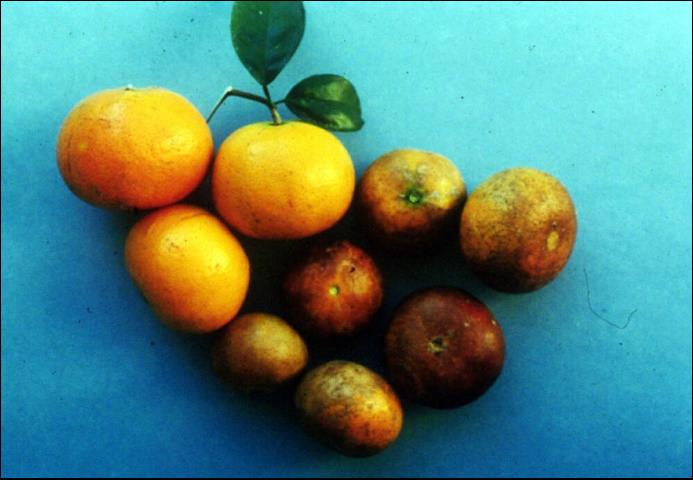
caused by mites: think both Organocide 3-in-1 and the cedar oil
Additional references:
https://edis.ifas.ufl.edu/hs141#FIGURE%2060
https://www.burkesbackyard.com.au/fact-sheets/in-the-garden/gardening-tips-books-techniques-and-tools/magnesium-deficient-plants/
http://ipm.ucanr.edu/PMG/C107/m107bpleaftwigdis.html
http://www.idtools.org/id/citrus/diseases/gallery.php?page=2
http://www.idtools.org/id/citrus/diseases/factsheet.php?name=Citrus%20black%20spot
http://www.crec.ifas.ufl.edu/extension/black_spot/citrus_black_spot.shtml
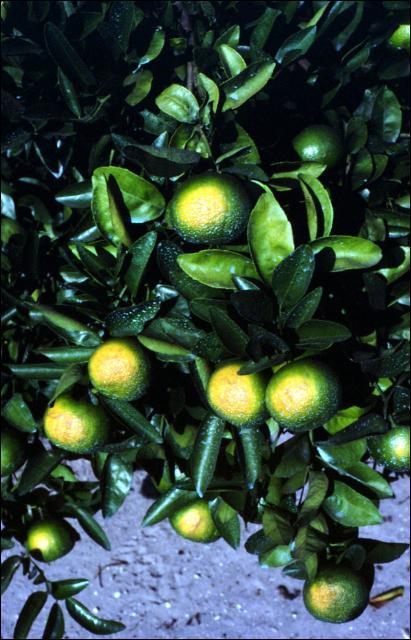
it's just sunburn!
Ok, so what's this a picture of?




